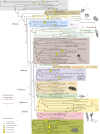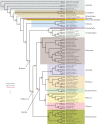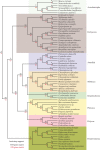Assessing the root of bilaterian animals with scalable phylogenomic methods
- PMID: 19759036
- PMCID: PMC2817096
- DOI: 10.1098/rspb.2009.0896
Assessing the root of bilaterian animals with scalable phylogenomic methods
Abstract
A clear picture of animal relationships is a prerequisite to understand how the morphological and ecological diversity of animals evolved over time. Among others, the placement of the acoelomorph flatworms, Acoela and Nemertodermatida, has fundamental implications for the origin and evolution of various animal organ systems. Their position, however, has been inconsistent in phylogenetic studies using one or several genes. Furthermore, Acoela has been among the least stable taxa in recent animal phylogenomic analyses, which simultaneously examine many genes from many species, while Nemertodermatida has not been sampled in any phylogenomic study. New sequence data are presented here from organisms targeted for their instability or lack of representation in prior analyses, and are analysed in combination with other publicly available data. We also designed new automated explicit methods for identifying and selecting common genes across different species, and developed highly optimized supercomputing tools to reconstruct relationships from gene sequences. The results of the work corroborate several recently established findings about animal relationships and provide new support for the placement of other groups. These new data and methods strongly uphold previous suggestions that Acoelomorpha is sister clade to all other bilaterian animals, find diminishing evidence for the placement of the enigmatic Xenoturbella within Deuterostomia, and place Cycliophora with Entoprocta and Ectoprocta. The work highlights the implications that these arrangements have for metazoan evolution and permits a clearer picture of ancestral morphologies and life histories in the deep past.
Figures




References
-
- Baguñà J., Riutort M.2004The dawn of bilaterian animals: the case of acoelomorph flatworms. Bioessays 26, 1046–1057 (doi:10.1002/bies.20113) - DOI - PubMed
-
- Bourlat S. J., Hejnol A.2009Acoels. Curr. Biol. 19, R279–R280 - PubMed
-
- Bourlat S. J., Nielsen C., Lockyer A. E., Littlewood D. T. J., Telford M. J.2003Xenoturbella is a deuterostome that eats molluscs. Nature 424, 925–928 (doi:10.1038/nature01851) - DOI - PubMed
-
- Bourlat S. J., et al. 2006Deuterostome phylogeny reveals monophyletic chordates and the new phylum Xenoturbellida. Nature 444, 85–88 (doi:10.1038/nature05241) - DOI - PubMed
-
- Castresana J.2000Selection of conserved blocks from multiple alignments for their use in phylogenetic analysis. Mol. Biol. Evol. 17, 540–552 - PubMed
Publication types
MeSH terms
LinkOut - more resources
Full Text Sources
Miscellaneous

